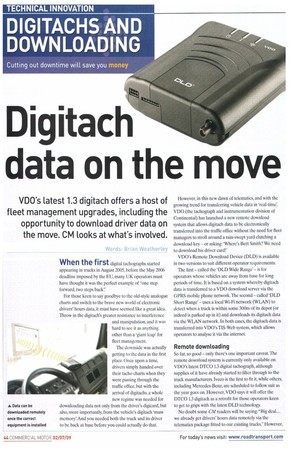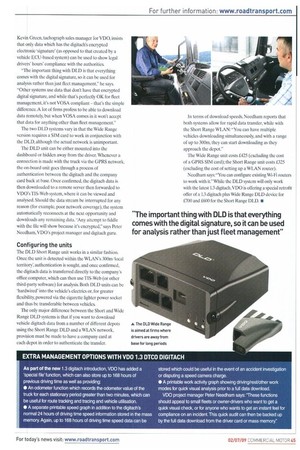CI igitach
Page 44

Page 45

If you've noticed an error in this article please click here to report it so we can fix it.
data on the move
VDO's latest 1.3 digitach offers a host of fleet management upgrades, including the opportunity to download driver data on the move. CM looks at what's involved.
440r US: Di an Weathertey When the first digital tachographs started appearing in trucks in August 2005, before the May 2006 deadline imposed by the EU, many UK operators must have thought it was the perfect example of "one step forward, two steps back" For those keen to say goodbye to the old-style analogue charts and switch to the brave new world of electronic drivers' hours data, it must have seemed like a great idea. Throw in the digitach's greater resistance to interference and manipulation, and it was hard to see it as anything other than a 'giant leap' for fleet management.
The downside was actually getting to the data in the first place. Once upon a time, drivers simply handed over their tacho charts when they were passing through the traffic office, but with the arrival of digitachs, a whole new regime was needed for downloading data not only from the driver's digicard, but also, more importantly, from the vehicle's digitach 'mass memory! And you needed both the truck and its driver to be back at base before you could actually do that. However, in this new dawn of telematics, and with the growing trend for transferring vehicle data in 'real-time', VDO (the tachograph and instrumentation division of Continental) has launched a new remote download system that allows digitach data to be electronically transferred into the traffic office without the need for fleet managers to stroll around a rain-swept yard clutching a download key — or asking: 'Where's Bert Smith? We need to download his driver card!'
VDO's Remote Download Device (DLD) is available in two versions to suit different operator requirements The first — called the 'DLD Wide Range' — is for operators whose vehicles are away from base for long periods of time. It is based on a system whereby digitach data is transferred to a VDO download server via the GPRS mobile phone network. The second — called `DLD Short Range' — uses a local Wi-Fi network (WLAN) to detect when a truck is within some 300m of its depot (or indeed is parked up in it) and downloads its digitach data via the WLAN network. In both cases, the digitach data is transferred into VDO's TIS-Web system, which allows operators to analyse it via the internet.
Remote downloading
So far, so good — only there's one important caveat. The remote download system is currently only available on VDO's latest DTCO 1.3 digital tachograph, although supplies of it have already started to filter through to the truck manufacturers. Iveco is the first to fit it, while others, including Mercedes-Benz, are scheduled to follow suit as the year goes on. However, VDO says it will offer the DTCO L3 digitach as a retrofit for those operators keen to get to grips with the latest DLD technology.
No doubt some CM readers will be saying: "Big deal... we already get drivers' hours data remotely via the telematics package fitted to our existing trucks." However, Kevin Green, tachograph sales manager for VDO, insists that only data which has the digitach's encrypted electronic 'signature' (as opposed to that created by a vehicle ECU-based system) can be used to show legal drivers' hours' compliance with the authorities.
"The important thing with DLD is that everything comes with the digital signature, so it can be used for analysis rather than just fleet management," he says. "Other systems use data that don't have that encrypted digital signature, and while that's perfectly OK for fleet management, it's not VOSA compliant that's the simple difference.A lot of firms profess to be able to download data remotely, but when VOSA comes in it won't accept that data for anything other than fleet management."
The two DLD systems vary in that the Wide Range version requires a SIM card to work in conjunction with the DLD, although the actual network is unimportant.
The DLD unit can be either mounted into the dashboard or hidden away from the driver. Whenever a connection is made with the truck via the GPRS network, the on-board unit goes through a process of authentication between the digitach and the company card back at base. Once confirmed, the digitach data is then downloaded to a remote server then forwarded to VDO's TIS-Web system, where it can be viewed and analysed. Should the data stream be interrupted for any reason (for example, poor network coverage), the system automatically reconnects at the next opportunity and downloads any remaining data. "Any attempt to fiddle with he file will show because it's encrypted," says Peter Needham, VDO's project manager and digitach guru.
Configuring the units
The DLD Short Range unit works in a similar fashion. Once the unit is detected within the WLAN's 300m 'local territory', authentication is sought, and once confirmed, the digitach data is transferred directly to the company's office computer, which can then use TIS-Web (or other third-party software) for analysis. Both DLD units can be 'hardwired' into the vehicle's electrics or, for greater flexibility, powered via the cigarette lighter power socket and thus be transferable between vehicles.
The only major difference between the Short and Wide Range DLD systems is that if you want to download vehicle digitach data from a number of different depots using the Short Range DLD and a WLAN network, provision must be made to have a company card at each depot in order to authenticate the transfer. In terms of download speeds. Needham reports that both systems allow for rapid data transfer, while with the Short Range WLAN: "You can have multiple vehicles downloading simultaneously, and with a range of up to 300m, they can start downloading as they approach the depot."
The Wide Range unit costs £425 (excluding the cost of a GPRS SIM card); the Short Range unit costs £325 (excluding the cost of setting up a WLAN router).
Needham says: -You can configure existing Wi-Fi routers to work with it.While the DLD system will only work with the latest 13 digitach. VDO is offering a special retrofit offer of a 1.3 digitach plus Wide Range DLD device for £700 and £600 for the Short Range DLD. •
















































































































































